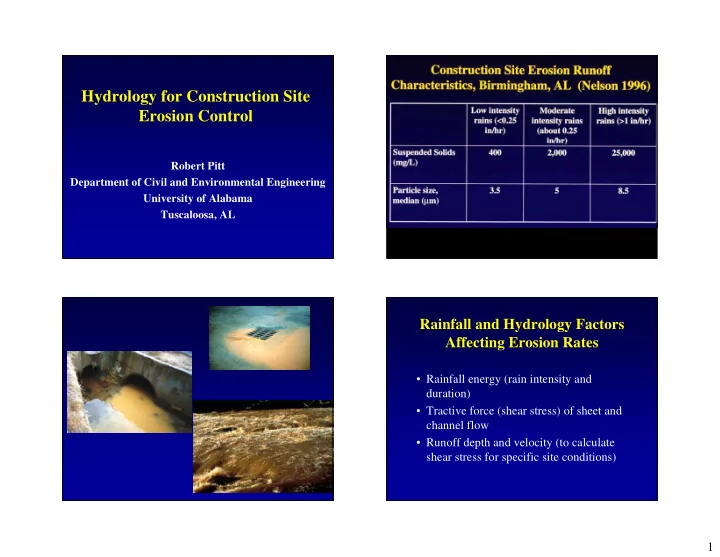

Hydrology for Construction Site Erosion Control Robert Pitt Department of Civil and Environmental Engineering University of Alabama Tuscaloosa, AL Rainfall and Hydrology Factors Affecting Erosion Rates • Rainfall energy (rain intensity and duration) • Tractive force (shear stress) of sheet and channel flow • Runoff depth and velocity (to calculate shear stress for specific site conditions) 1
Hydrology Parameters Needed for the Factors Affecting Runoff Design of Construction Site Erosion Control Practices • Rainfall – The duration of the storm and the distribution of the rainfall during the storm are the two major factors affecting the peak rate of runoff. • Mulches – water velocities and water depth The rainfall amount affects the volume of runoff. • Ditch liners – water velocities and water depth • Soil conditions – antecedent moisture conditions • Slope down shoots – peak flow rates generally affects the infiltration rate of the rainfall falling on the ground. Soil texture and compaction • Diversion dikes and swales – peak flow rates (structure) usually has the greatest effect on the • Filter fabric fences – water velocities and infiltration. hydrographs • Surface cover – the type and condition of the soil • Sediment ponds – water volume and surface cover affects the rain energy transferred to hydrographs the soil surface and can affect the infiltration rate also. Birmingham Intensity - Duration - Frequency (IDF) Curve Time of Concentration (t c ) • The duration must be equal to the time of concentration for the drainage area. • The time of concentration (t c ) is equal to the longest flow path (by time). • If the t c is 5 min for a storm having a return period of 25 years, the associated peak intensity (which has a duration of 5 min) would be about 8.6 in/hr. • If the t c for this same return period was 40 min, the peak rain intensity would be “only” 3.8 in/hr. 2
Rainfall Frequency • Rainfall frequency is commonly expressed as the average return period of the event. • The value should be expressed as the probability of that event occurring in any one year. • As an example, a 100-yr storm, has a 1% chance of occurring in any one year, while a 5-yr storm has a 20% chance of occurring in any one year. • Multiple rare events may occur in any one year, but that is not very likely. SCS (NRCS) Rainfall Distributions 3
Zones of Different Rainfall Distributions Rainfall Distributions in the Southeastern U.S. SCS (NRCS) TR-55 Curve Number Model of Rainfall vs. Runoff Probability of design storm (design return period) not being exceeded during the project life (design period). As an example, if a project life was 5 years, and a storm was not to be exceeded with a 90% probability, a 50 year design return period storm must be used. 4
Typical CN Values for Pastures, Grasslands, and Woods Typical curve number (CN) values for urban areas. Time of Concentration Estimates Figure illustrating sheetflow travel time • The TR-55 procedures estimate t c using three for dense grass flow segment types: surfaces, for varying – Sheetflow (maximum of 300 ft) slopes and flow – Shallow concentrated flow (paved or unpaved lengths. surfaces – Channel flow (using Manning’s equation) • Candidate t c pathways are drawn on the site map and the travel times for the three flow segments are calculated. • The t c for the drainage area is the longest travel time calculated. 5
NRCS Travel Time Example: Figure illustrating A-B sheetflow (100 ft) shallow concentrated B-C shallow concentrated flow (1,400 ft) flow velocities for paved C-D channel flow (7,300 ft) and unpaved surfaces and for different slopes. Tabular Hydrograph Method • The NRCS TR-55 Tabular Hydrograph Method uses watershed information and a single design storm to predict the peak flow rate, the total runoff volume, and the hydrograph. • Information needed includes: – Drainage area (square miles) – Time of concentration (hours) – Travel time through downstream segments (hours) – 24-hr rainfall total for design storm – Rainfall distribution type – Runoff curve number (and associated initial abstraction) 6
Layout of Subwatersheds for NRCS Example The dimensionless unit hydrograph is selected from tables in TR-55 The initial abstraction values (mostly detention storage) are a direct function of the curve number. 7
8
9
10
Subdrainages on and near construction site affecting control design. Upslope and downslope drainage areas for construction site. Acceptable Levels of Protection for Different Upslope Subdrainage Area Characteristics Site Activities (1 year construction period) Calculation Acres Cover Flow CN t c Acceptable Design Storm 24-hr Rain objective n path (min) slope Failure Rate Return Depth Diversion 25% 6.5 years 5.5 inches U1 Direct to Hydrograph (to 37.4 0.4 8 % 73 29 site be combined channels with U2 and U3) Main site 5% 20 6.6 channel U2 Diversion Peak flow rate 14.6 0.4 11.5 73 25 to site and hydrograph Site slopes 10% 10 6.0 stream (to be combined with U1 and U3) Site filter 50% 1.9 4.0 fence U3 Diversion Peak flow rate 2.4 0.4 12.7 73 20.7 to site and hydrograph Sediment 5% and 1% 20 and 100 6.6 and 8.4 stream (to be combined pond with U1 and U2) 11
Alabama Rainfall Conditions • Are there specific rains that are most important from an erosion control viewpoint? (yes, about 5 rains a year are responsible for about half of the annual erosion. These are greater than about 1.5 inches in depth) • Are there seasons of the year that are less prone to erosion than other times? (not really; June, July and August, plus October and November generally have had fewer of these large rains, but they may occur during any month) • Intensity-Duration-Frequency curves used for hydrology calculations. 12
Recommend
More recommend